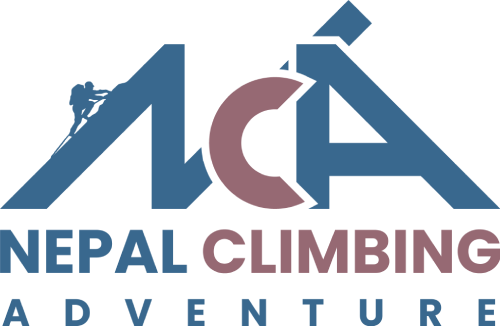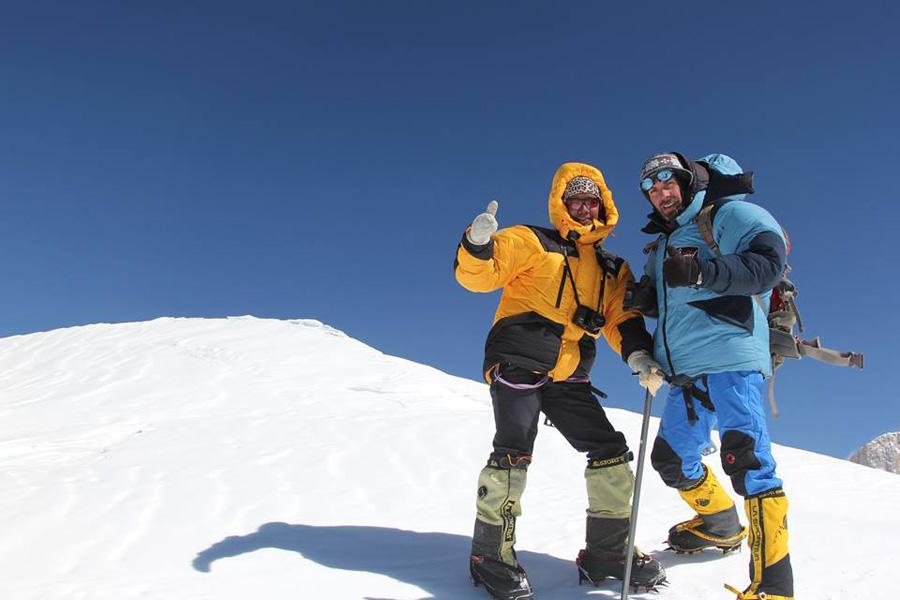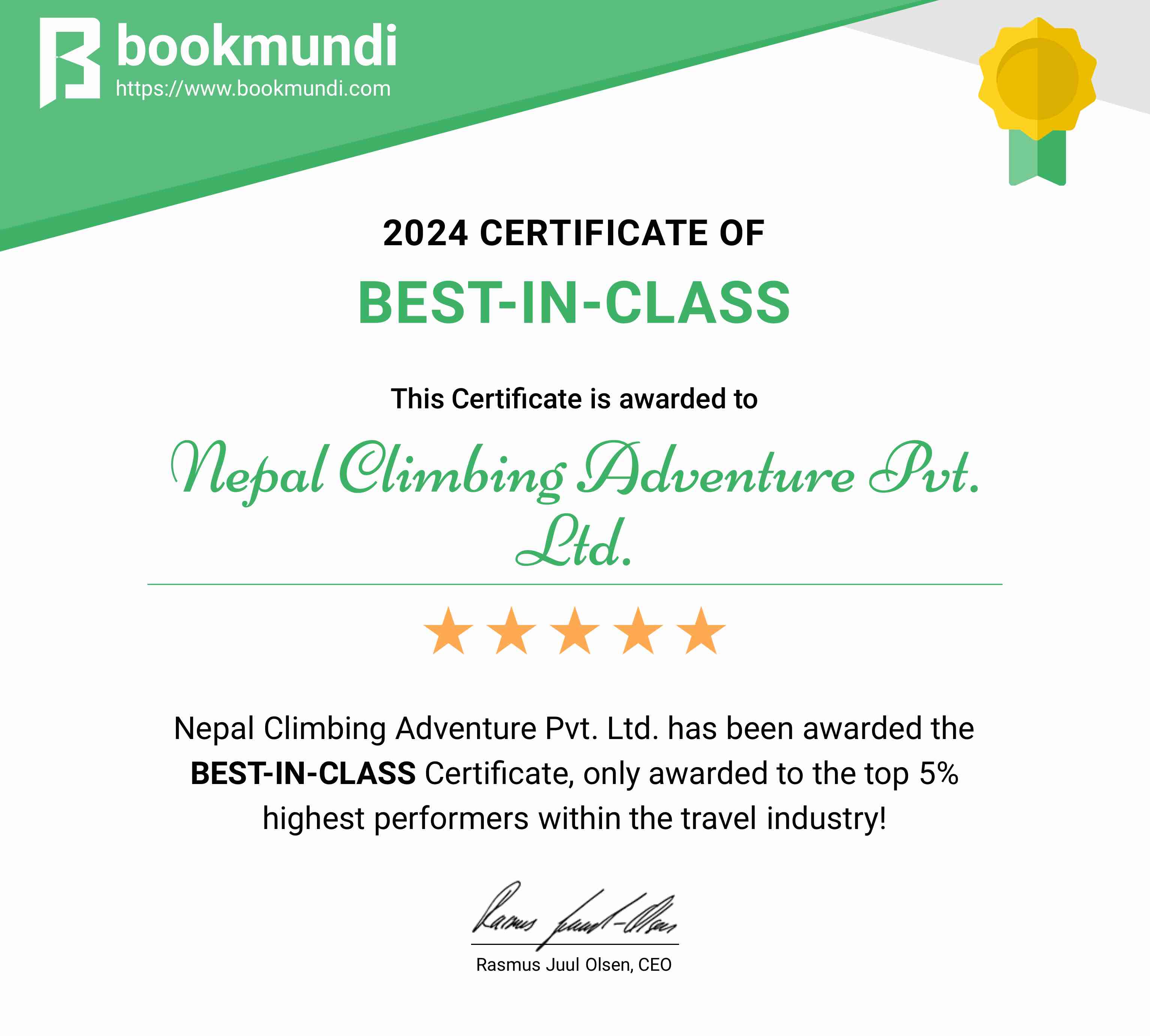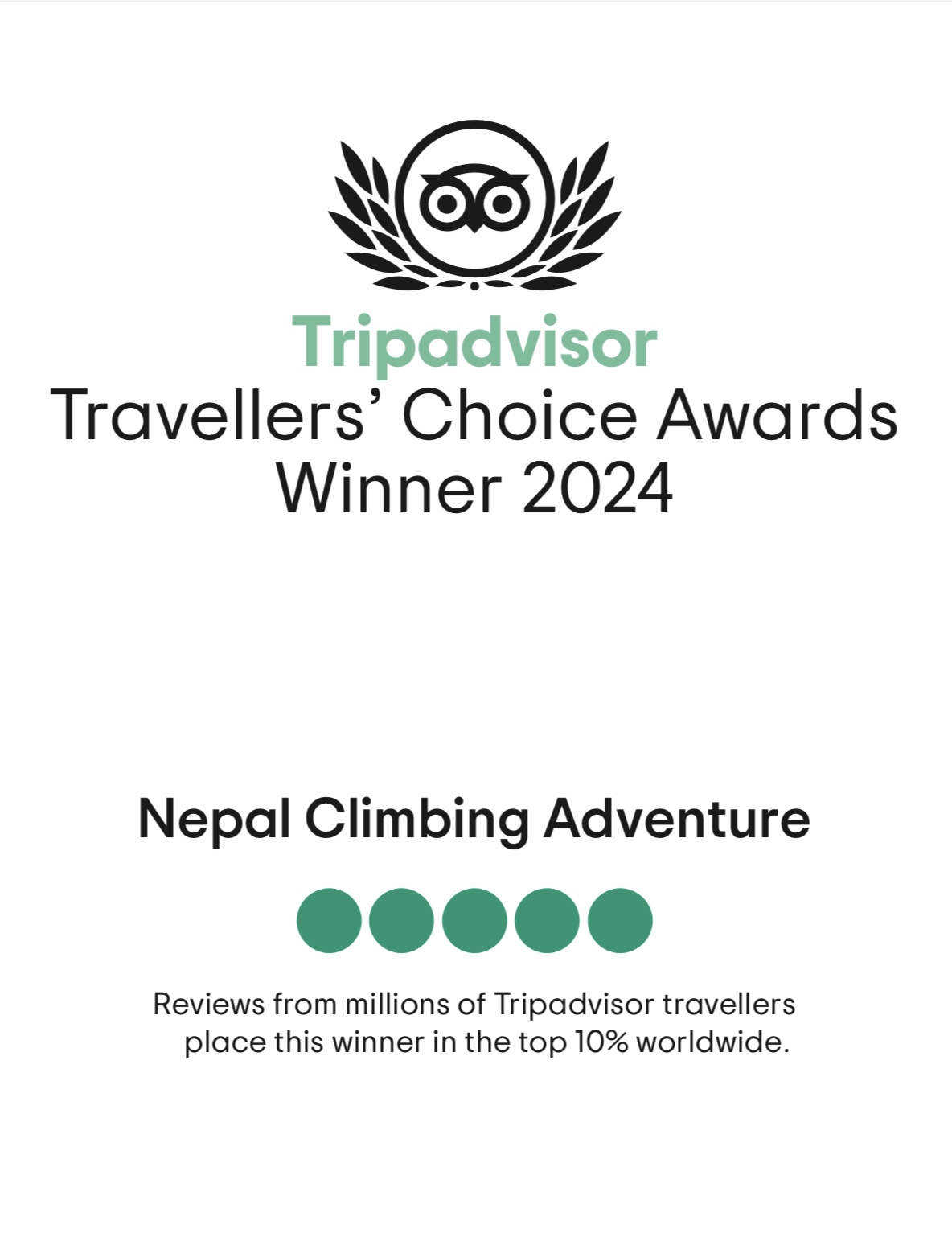Baruntse Expedition is a highly technical climbing adventure in the Himalayas. The mountain stands at 7129m (23,390ft) above sea level and attracts mountain climbers yearly to attempt the summit.
Overview:
Baruntse is a beautiful mountain peak in the Southeast corner of the Everest National Park. It towers beautifully between two 8,000 meters mountains – Lhotse and Makalu. Baruntse Expedition is a highly technical adventure. Baruntse Peak 7129M Expedition is above sea level and attracts mountain climbers every year to attempt the summit.
Many climbers have successfully summited Mt. Baruntse ever since Colin Todd and Geoff Harrow summited the mountain for the first time on 30 May 1954 from the South-East ridge. This Expedition is in many regards the ideal climbing adventure for the mountaineers attempting a 7,000-meter mountain.
Despite the fact that its elevation is not as much as neighboring mountains, you will be in the very heart of the compelling Himalayan Mountains. You can enjoy the view of the Lhotse South Face and the staggering Makalu west column. This expedition demands a significant number of skills required for climbing all 8000-meter peaks. With proper Baruntse Expedition Preparation you can plan an expedition on an 8000-meter mountain like Everest Expedition or Manaslu Expedition.
You will trek through the route that the Mera Peak Climbing adventure takes. Traversing peaceful trails in the region, you will make your way all the way to Baruntse Base Camp Expedition and prepare for the expedition. During the Baruntse 32 days Climbing Expedition, you can enjoy the thrilling adventure of climbing to the summit of beautiful Baruntse.
Reasons Baruntse Expedition becomes an Experience
Nepal Climbing Adventure always strives to offer an adventure traveling experience that you can cherish. While this expedition is beautiful in its all essence, your experience of trekking there becomes even more beautiful with us.
By the time we take you to the base camp and bring you back, we take one step ahead to offer you a beautiful experience. We keep your safety and happiness is our top priority and you will experience the same during the trip.
Going on the Mount Baruntse Expedition with us is traveling in safe hands.
Baruntse Climbing History:
Baruntse Mountain in Nepal, standing at 7,129 meters (23,389 feet). It is located in the Mahalangur range of the Himalayas, between Everest and Makalu. The mountain was first climbed on May 30, 1954, by a team of New Zealanders, including Colin Todd and Geoff Harrow. This expedition was notable because it was among the first successful climbs of a peak over 7,000 meters in the Everest region.
The route taken by Todd and Harrow was via the Southeast Ridge, which has since become the standard route for climbers attempting Baruntse. The climb involves technical sections, including steep ice and snow slopes, making it a challenging ascent. Despite these difficulties, Baruntse is considered more accessible compared to its higher neighbors, Everest and Makalu.
Baruntse has a relatively low number of climbers each year, which helps preserve its pristine environment. This also means fewer crowds, providing a more serene Baruntse Climbing Experience. The mountain is surrounded by breathtaking scenery, including the stunning Barun Valley, known for its rich biodiversity and beautiful landscapes.
In recent years, Baruntse Peak Climbing Expedition gained popularity among climbers seeking to train for higher peaks. It offers a good test of skills required for 8,000-meter peaks, such as crevasse navigation, ice climbing, and high-altitude endurance. Many commercial expeditions now offer guided climbs to Baruntse, attracting adventurers from around the world.
The history of Baruntse Peak Climbing Expedition is marked by a spirit of exploration and adventure. Over the decades, climbers from various countries have summited the peak, contributing to a rich legacy of mountaineering. Each ascent of Baruntse is a testament to human determination and the allure of the high Himalayas. Today, Baruntse remains a sought-after destination for mountaineers looking to experience the challenges and beauty of the Himalayan range.
Baruntse Peak Expedition Climbing Route:
The Baruntse Climbing Route is very popular in Nepal, located in the heart of the Himalayas. Baruntse Peak, standing at 7,129 meters, is stunning and surrounded by famous mountains like Everest, Lhotse, and Makalu. The journey begins in Kathmandu, where climbers prepare and gather necessary permits. The expedition typically starts with a flight to Lukla, a small town with an airport. From Lukla, climbers trek through beautiful valleys and traditional Sherpa villages. The trail passes through the Sagarmatha National Park, offering views of lush forests and diverse wildlife.
The first major stop is at the village of Namche Bazaar, a bustling hub for trekkers and climbers. Here, climbers acclimatize to the altitude before continuing. The route then leads to the serene village of Chukhung, providing more time for acclimatization and rest.From Chukhung, the path heads towards the Barun Valley, known for its breathtaking scenery and remote wilderness. This section of the Baruntse Trek is less crowded, allowing climbers to enjoy the solitude and natural beauty. Base Camp is established at around 5,300 meters, at the foot of Baruntse.
Climbers spend several days here, acclimatizing and preparing for the ascent. The climb involves setting up higher camps at around 6,100 meters and 6,400 meters. Baruntse Summit push begins from the High Camp. Climbers navigate challenging sections of ice and snow, including a steep ice wall near the summit ridge. This part requires technical skills and the use of fixed ropes. The final ascent to the summit is exhilarating, offering panoramic views of the surrounding peaks.
After reaching the summit, climbers descend back to Base Camp, retracing their steps through the Barun Valley and Chukhung. The trek concludes with a return to Lukla and a flight back to Kathmandu. This expedition is a remarkable journey, combining the thrill of high-altitude climbing with the serene beauty of the Himalayas. It requires good physical fitness, technical climbing skills, and the ability to acclimatize to high altitudes. Successful climbers are rewarded with unforgettable memories and stunning views from the summit.
Best Time for Baruntse Summit Climbing Expedition:
The best time for this Baruntse Climbing Expedition is during the pre-monsoon (spring) and post-monsoon (autumn) seasons in Nepal. These periods offer the most stable weather and the best conditions for climbing.
Spring Season (April to May): This is one of the most popular times for expeditions. During spring, the weather is relatively warm, and the days are longer, providing more daylight for climbing. The temperatures are moderate, which is ideal for mountaineering. Moreover, the spring season is known for its clear skies, offering spectacular views of the surrounding peaks. However, it is also a busy season, so you can expect more climbers on the mountain.
Autumn Season (September to November): Autumn is another favorable time for the Baruntse Peak expedition. The weather during this period is usually stable and dry, with clear skies and mild temperatures. This season is also less crowded compared to spring, offering a more peaceful climbing experience. The post-monsoon period ensures that the landscape is lush and green, enhancing the beauty of the trek to Baruntse. The nights can be colder, but the daytime temperatures are generally comfortable for climbing.
Winter and Monsoon Seasons (December to February and June to August): These periods are less suitable for this expedition. The winter season brings extremely cold temperatures and heavy snowfall, making climbing conditions very challenging and dangerous. The monsoon season, on the other hand, is characterized by heavy rainfall, which leads to slippery trails, increased risk of landslides, and poor visibility. The constant rain and cloud cover also make it difficult to enjoy the scenic views.
Difficulty Level of Baruntse Expedition
The baruntse difficulty is considered a moderately demanding climb, appealing to those with some high-altitude mountaineering experience. Baruntse stands at 7,129 meters (23,390 feet) in the Himalayas of Nepal. While it is not as high as some of the 8,000-meter peaks, it still presents significant challenges. Baruntse Climb involves technical sections, particularly on the summit ridge, which can be steep and exposed. Climbers need to be proficient in using crampons, ice axes, and ropes. Experience in climbing on ice and snow is essential. The route also includes crossing crevasses and navigating through serac fields, which can be hazardous.
Acclimatization is a critical part of the Baruntse Climbing Expedition due to the high altitude. The approach to the base camp and subsequent camps allows climbers to gradually adjust to the lower oxygen levels. This process helps prevent altitude sickness, which can be a serious risk. Weather conditions in the Himalayas can be unpredictable and harsh. High winds, heavy snowfall, and sudden weather changes are common. Climbers need to be prepared for these conditions and have the appropriate gear to handle the cold and storms. The difficulty of Baruntse High Camp Expedition lies in its technical climbing sections, requiring climbers to have excellent physical fitness and mountaineering skills.
Physical fitness is another crucial factor. The trek to base camp itself is long and demanding, often taking several days through rugged terrain. Carrying heavy loads and climbing for extended periods requires both strength and mental resilience. Organizing a successful expedition involves coordinating supplies, arranging permits, and ensuring communication and safety measures are in place. Many climbers join guided expeditions led by experienced mountaineers, which can provide additional support and increase the chances of a successful summit.
Baruntse Expedition Cost:
The cost of this expedition can vary significantly based on several factors such as the services provided, the duration of the expedition, the size of the group, and the company organizing the trip. On average, this expedition cost ranges from $8,000 to $12,000 per person. This price typically includes several essential services and amenities. First, it covers the necessary permits and fees for climbing Baruntse, which are mandatory for all climbers. It also includes domestic flights within Nepal, such as from Kathmandu to Lukla, which is a common starting point for the trek to Baruntse Base Camp Expedition.
The cost often covers the expenses of a professional expedition Guide and support staff, including Sherpas, cooks, and porters. These professionals are crucial for a safe and successful expedition. The price also includes the use of group climbing equipment, such as ropes and tents, as well as personal equipment like crampons and harnesses, which might be rented or provided by the expedition company. Accommodation and meals during the trek and at the base camp are usually included in the cost. This ensures that climbers are well-fed and rested throughout their journey.
The expedition cost often covers the expenses of establishing and maintaining the base camp and Baruntse High Camps, which is essential for acclimatization and safety. Medical supplies and emergency equipment, such as oxygen cylinders and first aid kits, are also typically included in the expedition cost. Insurance, however, is usually not included, so climbers need to arrange their own travel and medical insurance. While these are the general inclusions, it's important to check with the specific expedition company for a detailed breakdown of what is covered in the cost. Some Baruntse Expedition Companies might offer additional services or charge extra for certain amenities.
Baruntse Climbing Permits:
A Baruntse climbing permit is essential for anyone planning to climb Baruntse, a prominent peak in Nepal. Situated at 7,129 meters, Baruntse lies between Everest and Makalu in the heart of the Himalayas. The permit is issued by the Nepal Mountaineering Association (NMA). To obtain a Baruntse climbing permit, you need to submit an application to the NMA. This application should include personal details, a passport-sized photograph, and a copy of your passport. You also need to provide details of your planned Baruntse Peak Expedition Itinerary and team.
The cost of the permit varies depending on the season. The peak climbing season is from March to May and September to November. During these times, the permit fee is higher due to the favorable weather conditions. In the off-season, from December to February and June to August, the permit cost is lower. In addition to the climbing permit, you need to secure several other documents. Baruntse Trekking requires a permit for the Makalu-Barun National Park and a TIMS (Trekkers’ Information Management System) card. You may also need a liaison officer appointed by the government to accompany your expedition.
The process of obtaining the permit can take several days. Therefore, it is advisable to apply well in advance of your planned expedition date. It is also important to ensure that all your documents are complete and accurate to avoid any delays. Climbing Baruntse requires careful planning and preparation. Securing the necessary permits is a crucial step in this process. With the right permits in hand, you can embark on your adventure to conquer this majestic Himalayan peak.
Weather:
This expedition offers a challenging yet rewarding mountaineering experience in the heart of the Himalayas. Baruntse Climbing Season plays a crucial role in the success and safety of climbers attempting Baruntse. Due to its elevation and proximity to other towering peaks like Everest and Lhotse, Baruntse experiences typical Himalayan weather patterns. In the spring, the weather is generally more stable with clear skies and milder temperatures. The monsoon season brings heavy rainfall and increased avalanche risks, making this period unsuitable for climbing. The autumn months offer another window of opportunity with stable weather conditions and clear views, attracting many climbers to attempt Baruntse during this time.
During the Baruntse Climbing Season, climbers can expect cold temperatures, especially at higher altitudes, and sudden weather changes are common, necessitating careful planning and preparedness. The temperature at the base camp can range from around -10°C to 10°C (14°F to 50°F) depending on the time of year, gradually decreasing as climbers ascend. Winds can also be a significant factor, particularly on exposed ridges and summit pushes, adding to the challenge and requiring climbers to be well-equipped with proper gear and clothing. Proper Baruntse Climbing Gear includes technical equipment like ice axes, crampons, climbing harnesses, and high-altitude clothing for safety and efficiency on this challenging peak.
Baruntse Weather forecasting plays a critical role in expedition planning, helping climbers choose the best windows for summit attempts while minimizing risks associated with adverse weather conditions. Baruntse Expedition Guide and teams often monitor weather updates closely, adjusting their schedules and strategies accordingly to maximize safety and summit success. While this expedition offers breathtaking views and a thrilling mountaineering challenge. For safe and successful Baruntse Ascent, climbers must respect and navigate the unpredictable Himalayan weather.
Detailed Baruntse Expedition Itinerary:
Let's dive into the Baruntse Expedition Itinerary, a thrilling adventure through the Himalayas blending challenging climbs with breathtaking views.
Day 01: Arrival in Kathmandu
After you arrive at the airport, you will be received by our representatives and taken to a hotel. After you check in, you will meet your travelling companions and a welcome dinner will be organized in the evening where you will be served with original Nepali cuisine and introduced to Nepali culture.
- Accommodation: Hotel
Day 02: Sightseeing in Kathmandu and preparation for the trip
After having breakfast, you will be briefed about the composition of your team, travel equipment and nature and strategy of the climb. All official procedures will be finalized and necessary arrangements will be made. Then there will be a guided tour of the major landmarks and UNESCO world heritage sites of Kathmandu valley like Kathmandu Durbar Square, Pashupatinath, Swoyambhunath and Boudhanath. In the afternoon, there will be a pre discussion before the expedition and the final preparation like checking the equipment will be done.
- Accommodation: Hotel
- Meal: Breakfast
Day 03: Flight to Lukla and trek to Chhuthang
Our early morning flight to Lukla, one of the world’s most beautiful and highest airports in the world, takes about 30 minutes. We will be seeing the likes of Everest mountain range and dense snow covered forests and beautiful landscape. As we land at the Tenzing and Hillary Airport, we will start our trek to Chhuthang after breakfast. We will walk through several forested areas. As we trek below the Kalo Himal aka. Black Mountain, we will trek towards open pasture ground at Chhuthang. Overnight in a camping tent.
- Accommodation: Guesthouse
- Meal: Breakfast, Lunch and Dinner
Day 04: Trek to Thuli Kharka via Zatrala Pass
After breakfast, we leave Chhuthang and take after the trail that is a step by step rise at first and after that a much more extreme climb towards the crossover of Zatrala Pass. Our tiring move to the highest point of the pass is remunerated with staggering perspectives of Numbur Himal, Kongde Ri, Karyolang Peak and other attractive high crests of the region. From the top our trail deviates towards Thuli Kharka.
- Accommodation: Guesthouse
- Meal: Breakfast, Lunch and Dinner
Day 05: Trek to Kothe
Today we begin a delightful trail that takes us down to Hinku River. We will make a fairly long climb through thick rhododendron filled forest to reach Kothe. Kothe is situated at the west side of Hinku valley and is popular for thick rhododendron forest. In spring, the slopes are loaded with red rhododendron blossoms that make this place one of the best in the most captivating spot on earth.
- Accommodation: Guesthouse
- Meal: Breakfast, Lunch and Dinner
Day 06: Trek to Thangnak
From Kothe we proceed with our trek on the trail that goes along the edge of Hinku River. As we approach the settlement of Gondishung, we go through Lungsumgba Gompa which was built around 200 years back. From here we can see Mera Peak with its route carved with rocks which is a perfect work of art. A lovely and simple trek will lead us to Thangnak where we remain for the night.
- Accommodation: Guesthouse
- Meal: Breakfast, Lunch and Dinner
Day 07: Trek to Khare
After breakfast we leave Thangnak and trek over the trail that goes over the icy way towards Kharka with mesmerizing sight of snow capped mountains. We proceed with our climbing that leads us to the beginning of Hinku Nup and Shar Glaciers. From that point, our trail is a lofty climb to Khare. From Khare we will get the opportunity to see the dazzling perspective of the Northern Face of Mera Peak. We spent our overnight at Khare.
- Accommodation: Guesthouse
- Meal: Breakfast, Lunch and Dinner
Day 08: Acclimatization at Khare
We will have a day to adapt ourselves to the varying altitude and climatic conditions to ensure ourselves for the summit of Mt. Baruntse. Hence, we will take a rest at Khare for acclimatization and visit the area. Also, Khare offers short hikes to its guests which are surprisingly best places for acclimatization and preparation for the journey onwards.
- Accommodation: Guesthouse
- Meal: Breakfast, Lunch and Dinner
Day 09: Trek to Mera La Pass
Heading for the days trip, we walk along the rocky trails above the western ridge of Mera glacier. There is a steep way onwards as we head towards Mera La Pass at 5,400m. From the very top of the pass, we will see the overwhelming view of the snow covered peaks of Khumbu region. We will descend down all the way towards our camping site.
- Accommodation: Camping
- Meal: Breakfast, Lunch and Dinner
Day 10: Trek to Seto Pokhari
Today we will take after the trail that heads higher into the yak field of the remote valley. Our trail leads straightforwardly into the epicenter of the world's towering mountains with amazing views of highly elevated valleys. After some season of trekking, we will reach our campground close to Seto Pokhari which signifies 'White Lake' in Nepali. Overnight at the campsite.
- Accommodation: Camping
- Meal: Breakfast, Lunch and Dinner
Day 11: Trek to Baruntse Base Camp
Leaving our campsite at Seto Pokhari, we head onwards through the remote area. We will meet Honku valley on the way which leads us to our campsite in the base camp of Mt. Baruntse. The Sherpa will build our tent and do the necessary preparations for the rest of the trip as we comfort ourselves enjoying the views around.
- Accommodation: Camping
- Meal: Breakfast, Lunch and Dinner
Day 12 - 23: Summit of Mt. Baruntse and back to the Base Camp
As the climb is done per the experience and ability of the climber themselves, there is no need for a day to day itinerary. Our guides will adopt a strategy keeping in their mind what best fits the climbers and their progress. Generally, the group will spend a couple days at the base camp practicing rope climbing and acclimatizing before moving over the base camp.After all the climbing we have done till now, no further notable problems are expected. To make the climb effective, we built two camps above Baruntse base camp. Two camps are set up over the base camp for climbing purposes. Camp 1 is set up just beneath the East Col. at a height of 5700m, and the Baruntse Camp 2 is on the southeast edge at an elevation of 6420m.
Above Camp 1, we ascend snow slopes at a 50 degree edge, past a backup summit (6745m). From here the course turns out to be more unpredictable. A progression of short, steep trails of snow and ice are followed until we pass onto the west side of the edge. This takes us to an ice cliff after which we have entry to the less demanding, more extensive slopes above which finally leads us to the summit at 7129m. The trek takes roughly ten hours. After accomplishing the summit of Baruntse, we descend down along the same course.
- Accommodation: Camping
- Meal: Breakfast, Lunch and Dinner
Day 24: Cleaning of Base camp and descent to Seto Pokhari
Finally achieving our passion to reach the summit of Mt. baruntse and gaining a lifetime experience of Mountain climbing, we look forward to completing our trip. As the base camp has been a place to stay for us, we will leave the place clear, as it was before respecting the motive of responsible ecotourism. We will descend down and retrace our path once again through the Honku valley to finally reach Seto Pokhari for the night stay.
- Accommodation: Camping
- Meal: Breakfast, Lunch and Dinner
Day 25: Trek to Mera La Pass
We continue our way back as we leave our camp and descend down through the alpine valley. After some time, we again walked uphill towards Mera La pass where we will camp for the coming night.
- Accommodation: Camping
- Meal: Breakfast, Lunch and Dinner
Day 26: Trek to Thagnak
From our camp, we start our trek by taking after the trail that trip steeply towards Mera La Pass. We will walk downhill for 6-7 hours all the way to reach Thagnak passing through khare for overnight stay.
- Accommodation: Guesthouse
- Meal: Breakfast, Lunch and Dinner
Day 27: Trek to Kothe
We leave Thagnak after breakfast and continue our trek downwards to reach Kothe around which we can enjoy the rhododendron, oaks and pine forests. We will stay overnight at a lodge.
- Accommodation: Guesthouse
- Meal: Breakfast, Lunch and Dinner
Day 28: Trek to Thuli Kharka
After breakfast in the morning, we proceed ahead through the dense rhododendron forest and pass through the western section of the Hinku valley to get to Tuli Kharka. Overnight at a lodge in Tulikharka.
- Accommodation: Guesthouse
- Meal: Breakfast, Lunch and Dinner
Day 29: Tuli Kharka to Lukla
As we come to the last day of our trek, we want to finish it with the same encouragement as the very first day and continue downwards. We will ascend to cross the Zatrawala pass and again descend to reach Lukla which is our destination for the remaining of the day and night stay.
- Accommodation: Guesthouse
- Meal: Breakfast, Lunch and Dinner
Day 30: Fly to Kathmandu
We take an early morning flight from Tenzing and Hillary Airport to Tribhuvan International Airport. Watching and enjoying the beautiful scenery of the amazing Khumbu region for the last time of the trip, we will have a short flight of about 40 minutes and back to Kathmandu. After reaching the hotel and refreshing, you can take a stroll around the Thamel area and buy souvenirs for your friends abroad. We will serve you with a farewell dinner later in the evening.
- Accommodation: Hotel
- Meal: Breakfast
Day 31: Rest at Kathmandu & Debriefing
Today, you will be visiting the Department Of Tourism for debriefing of the expedition and receive the certificate of accomplishment.
- Accommodation: Hotel
- Meal: Breakfast
Day 32: Departure
Our airport representative will drop you off and make the necessary arrangements for the flight. Waving goodbye and exchanging wishes, you will finally leave Nepal after a memorable trip of your lifetime.
- Meal: Breakfast
What is included?
- All types of organizational requirements
- All trekking and climbing paper works and permits
- All airport and hotel transfers
- Welcome and farewell dinner
- Accommodation and meals during the whole of the expedition
- Flight from Kathmandu to Lukla and back
- Government and local taxes
- Reference notes to plan your trip
- An experienced English speaking climbing guide, assistant climbing guide, Sherpa porters including their salary, insurance, food, lodging and all equipment
- A comprehensive medical kit
- Facilities of Email and satellite phones in base camp
- Necessary oxygen bottles
- Written and photo internet dispatches to send your progress to your family
What is not included?
- Nepal Visa fee(bring small denomination cash USD and two passport photographs)
- International airfare
- Excess baggage charges
- Extra night accommodation apart from the schedule due to any reasons
- Lunch and evening meals in case of early return than the scheduled itinerary
- Travel and rescue insurance
- Charges of Email and satellite phones
- Charge for extra Sherpa porter (if required)
- Personal expenses
- Tips for climbing guide and Sherpa
There are a number of things that you need to keep in mind if you ever plan for your vacation. Because you want to make the most out of your limited time, it is truly a hectic job for you to find a trustworthy and experienced traveling companion. With Nepal Climbing, you have your problem solved already as we are one of the leading Trekking and Mountaineering organizations in Nepal and have been providing first class service in several travelling packages across the country for many years.
We prioritize your satisfaction and safety
At Nepal Climbing Adventure, our ultimate objective is to arrange the programs for you to make the most out of your valuable time. We value your satisfaction, adventure, amusement and safety. Regardless of whether you are searching for stunning perspectives along the trekking trails in Himalayan mountain range or widely acclaimed, heavenly attractions with developed societies, our exposure and experience in travel business will help you ensure your requirements are met.
We have professional staffs and service
We trust that extraordinary staff lead awesome administration. That is the reason we are collaborated with experienced and eager individuals. We possess authorized and government certified guides who are very much furnished with broad learning of Nepali communities and traditions. They additionally have familiar English speaking abilities and hierarchical capacities to encourage all types trekking groups.
Responsible Tourism and social values
We are endeavoring to lessen the effect of tourism by guaranteeing our staff are very much aware of ecological issues. We are doing our best to create less waste as could be expected under the circumstances and make a point to reclaim non-compostable wastes. We outline our itineraries and work in the field guided by the standards of ecotourism and reasonable tourism. Moreover, all our staff have been given ecological preparing and are extremely aware to the eco-system we enter. Additionally, we are adhering to sustainable assets of energy. Our guides will share you the social values, culture and religious harmony for better understanding the groups you visit.
Customizable Service
Our promise is to provide you with the travelling packages customizable according to your demand fulfilling your budget criteria. So, we can facilitate a minimum of 2 individuals with a personalized service at a reasonable cost.
Excellent Sherpas/guides. Strong porters. On going support.
Borys Darmas
V good Sherpas and Cook Responded to critical situation well to make the final ascend a success.
Borys Darmas
Online Payment
Or
WIRE TRANSFER
Bank Details:
Account Holder's Name: Nepal Climbing Adventure Pvt. Ltd.
Bank Name: Himalayan Bank Ltd.
Account Number: 01907449340018
Account Type: USD
Address: Thamel, Kathmandu, Nepal
SWIFT CODE: HIMANPKA
For more detail contact us:
Krishna Subedi (Chris Chhetri): +977 9851076791 (24/7, Call/Viber/Watsapp)
We recommend our guests have a valid insurance policy before undertaking an adventure in Nepal Himalaya. During treks and expeditions, the insurance should cover for expenses such as air ambulance, helicopter rescue, and medical care. As an adventure operator, we (NCA), are not permitted to arrange or sell insurance packages here in Nepal as per the Government of Nepal.
Frequently Asked Questions (FAQs):
1. What is the elevation of Baruntse base camp?
The elevation of Baruntse Base Camp is approximately 5,400 meters (17,717 feet) above sea level. It serves as a starting point for climbers aiming to summit Baruntse, a prominent peak in the Himalayas situated between Everest and Makalu.
2. Is Baruntse a hard climb?
Baruntse is a challenging climb that involves mixed scrambling, steep rocky scree, glacier crossings with crack, ladder crossing, and a steep Head-Wall to the west col. It is even more strenuous considering that you have already climbed Mera peak, which is also a demanding endeavor.
3. How long does the Mount Baruntse Expedition take?
The entire expedition usually lasts for approximately 30 to 35 days, which includes trekking to the base camp, acclimatization, and the ascent.
4. What kind of physical fitness is required for climbing Baruntse?
It is highly recommended for climbers to have excellent physical condition, including strong cardiovascular fitness and endurance. Prior experience in high-altitude climbing is highly recommended.
5. Do I need prior climbing experience?
Yes, prior experience in high-altitude mountaineering, including technical climbing skills with crampons, ice axes, and ropes, is necessary.
6. Will there be support staff on the expedition?
Yes, the expedition will typically include experienced guides, porters, and Sherpas to assist with carrying gear, setting up camps, and providing support on the climb.
7. How are meals and accommodations handled during the expedition?
Meals are provided by the expedition team and are usually prepared by the cook staff. Accommodations include camping at various points along the route and in tea houses during the trek to base camp.
8. What are the common risks and challenges of this expedition?
Baruntse Altitude include Common risks like sickness, extreme weather conditions, cracks, avalanches, and technical climbing challenges. Proper acclimatization and preparation are crucial to mitigate these risks.





















 Chris Chhetri
Chris Chhetri